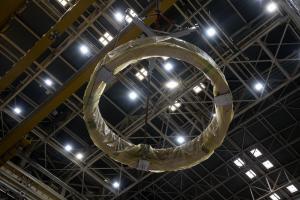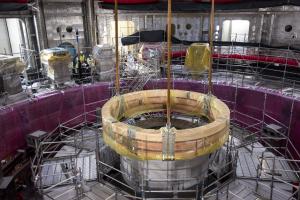A set of spares for the long journey
In about five years, ITER will embark on a long journey through largely uncharted territory. Conditions will be harsh and—despite all the calculations, modelling, prototyping and testing—some of the components might fail. Although such a probability is low, spares must be on hand, ready to replace the faulty component and allow operations to proceed.
Of all the ITER systems, the massive arrangement of coils that form the "magnetic cage" shaping and confining the plasma is one of the most strategic. None of the elements can be allowed to fail; as a result, engineers have planned spares for all of them. When components are identical, spares are ... just spares, like a spare tire in the trunk of a car (although much more challenging to replace). This is the case for the central solenoid (six modules are needed, seven will be manufactured), for the toroidal field coils (18 are needed, 19 will be manufactured), and for the current leads and the pre-compression rings.
For the poloidal field coils, which are all unique, manufacturing spares was not conceivable and a different solution was devised. Each coil has a spare double pancake embedded in its structure and is equipped with a system that allows for "bridging" any possible faulty double pancake using jumpers outside the coil.
On Thursday 8 July, the assembly sequence called for the positioning of the first of the "identical spares" of the ITER tokamak—an extra set of three pre-compression rings that was placed at the bottom of the assembly pit, fitting in the tight space between the bottom cylinder of the central column tool and the recently installed poloidal field coil #6. At a later stage, the set will be attached to the lower flanges of the toroidal field coils.
The spare pre-compression rings have been installed early as "captive" components under the vacuum vessel and toroidal field coils. Using them as spares to replace one, or a whole set, of faulty pre-compression rings, however, would be an extremely delicate operation that would necessitate the removal of the central solenoid and require at least six months. In addition, it would only be possible before full-power operation¹.
The pre-compression rings are designed to outlive the ITER machine and the probability of a failure is extremely low. In addition, there are margins in the design that would allow the machine to operate with one failed ring or with a partial loss of pre-load from the whole set. In this context, the spare rings are a second level of back up to ensure that, whatever that the hardships encountered, the journey will continue.
¹The forces exerted on the pre-compression rings during the first phase of operations will be the same as those they will face during the full-power phase. Should a failure occur, it would be during the first few years of machine operation.



